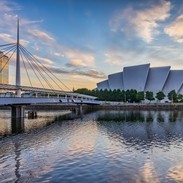2.7. Have you got the energy?
Key Takeaways 2.6
In a nutshell
Review all your energy needs and uses.
Draw up a to do list of improvements, along with a timetable to make sure you get them all done.
Renewable energy
Renewable energy comes from a source that doesn’t run out. These sources are natural and self-replenishing, and usually have a low- or zero-carbon footprint. Examples include solar, wind, hydroelectricity, and tidal.
Every business is different, so it is wise to get specific advice from an energy efficiency specialist. You can watch VisitEngland’s webinar with information on renewable energy options.
Switching to renewable energy sources reflects the philosophy of regenerative tourism and tallies with a circular economy approach which we discussed in section 2.9. In some cases, it is even possible to generate your own energy from, for example, solar panels. In some cases, you can even sell the surplus back to the grid.
Energy efficiency
Lighting
The headlines here are fairly straightforward. The longer that lights are switched on, the more energy will be used. Meeting rooms, storage areas and corridors are often lit unnecessarily.
It is a myth that turning lights off and back on uses more energy than leaving them on all the time.
Heating and cooling
Heating and cooling are usually the most significant energy costs in a business. Preventing heat loss through effective insulation and blocking draughts can significantly reduce costs, so it is a good place to start improving energy efficiency.
Here are some additional energy saving steps to consider.
Boost your energy efficiency
Lighting
Are all your lights LEDs and energy efficient? ⬜ Do you have continuous lighting in rooms that do not need it? Consider switching to motion sensor lights, timed switches and daylight sensors. ⬜ Do you have an automatic system that turns off lights when leaving guest/meeting rooms? ⬜ Is outside lighting minimised and/or have automatic turn off sensors been installed? ⬜ Are staff aware of their responsibility to turn off lights? ⬜ Are you making maximum use of natural light? Consider relocating workstations to well-lit areas. ⬜ Have you considered lighter paint colours or reflective paint? ⬜ Have you considered vertical window blinds, which let in more light than horizontal ones when open or closed? ⬜ Heating and Cooling
Do you have your heaters or boilers serviced regularly? ⬜ Are portable heaters being used unnecessarily? ⬜ Is the heating and air conditioning operating at the same time in the same place? ⬜ Are hot water tanks, boilers and pipes insulated? ⬜ Have you installed heating reflectors? ⬜ Do you have correctly set smart heating controls?
Make sure you consider weekends and bank holidays when setting controls. Set the heating in offices to 19°C and cooling at 24°C or higher. The temperature in corridors, storerooms and areas of higher physical activity can be set lower than 19°C.
⬜ Is someone responsible for changing the heating times at different times of the year? ⬜ Are windows left open when the heating is on? ⬜ Are radiators free from obstructions? Check that employee desks are not too close or too far from radiators and air conditioning. ⬜ Are at least 75% of all windows energy efficient at a higher standard than the national/local regulation? ⬜







